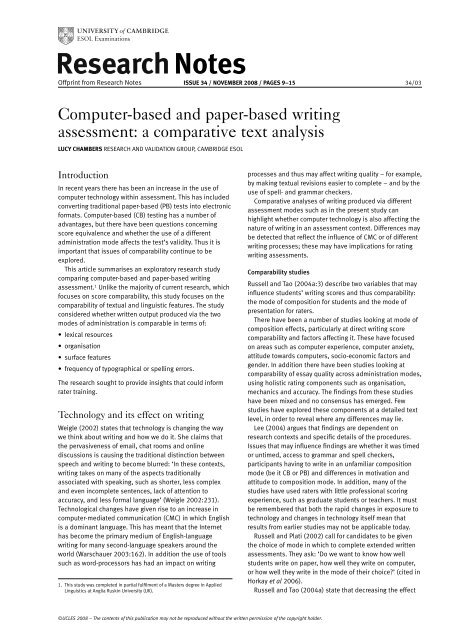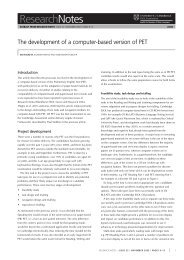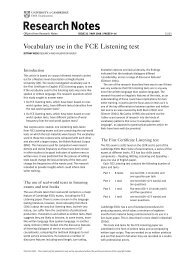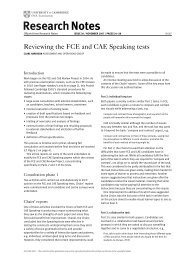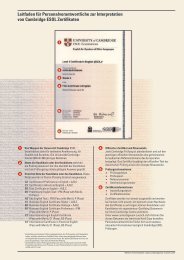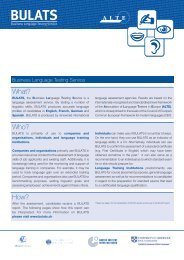Computer-based and paper-based writing assessment: a ...
Computer-based and paper-based writing assessment: a ...
Computer-based and paper-based writing assessment: a ...
Create successful ePaper yourself
Turn your PDF publications into a flip-book with our unique Google optimized e-Paper software.
Research NotesOffprint from Research Notes ISSUE 34 / NOVEMBER 2008 / PAGES 9–15 34/03<strong>Computer</strong>-<strong>based</strong> <strong>and</strong> <strong>paper</strong>-<strong>based</strong> <strong>writing</strong><strong>assessment</strong>: a comparative text analysisLUCY CHAMBERS RESEARCH AND VALIDATION GROUP, CAMBRIDGE ESOLIntroductionIn recent years there has been an increase in the use ofcomputer technology within <strong>assessment</strong>. This has includedconverting traditional <strong>paper</strong>-<strong>based</strong> (PB) tests into electronicformats. <strong>Computer</strong>-<strong>based</strong> (CB) testing has a number ofadvantages, but there have been questions concerningscore equivalence <strong>and</strong> whether the use of a differentadministration mode affects the test’s validity. Thus it isimportant that issues of comparability continue to beexplored.This article summarises an exploratory research studycomparing computer-<strong>based</strong> <strong>and</strong> <strong>paper</strong>-<strong>based</strong> <strong>writing</strong><strong>assessment</strong>. 1 Unlike the majority of current research, whichfocuses on score comparability, this study focuses on thecomparability of textual <strong>and</strong> linguistic features. The studyconsidered whether written output produced via the twomodes of administration is comparable in terms of:• lexical resources• organisation• surface features• frequency of typographical or spelling errors.The research sought to provide insights that could informrater training.Technology <strong>and</strong> its effect on <strong>writing</strong>Weigle (2002) states that technology is changing the waywe think about <strong>writing</strong> <strong>and</strong> how we do it. She claims thatthe pervasiveness of email, chat rooms <strong>and</strong> onlinediscussions is causing the traditional distinction betweenspeech <strong>and</strong> <strong>writing</strong> to become blurred: ‘In these contexts,<strong>writing</strong> takes on many of the aspects traditionallyassociated with speaking, such as shorter, less complex<strong>and</strong> even incomplete sentences, lack of attention toaccuracy, <strong>and</strong> less formal language’ (Weigle 2002:231).Technological changes have given rise to an increase incomputer-mediated communication (CMC) in which Englishis a dominant language. This has meant that the Internethas become the primary medium of English-language<strong>writing</strong> for many second-language speakers around theworld (Warschauer 2003:162). In addition the use of toolssuch as word-processors has had an impact on <strong>writing</strong>1. This study was completed in partial fulfilment of a Masters degree in AppliedLinguistics at Anglia Ruskin University (UK).processes <strong>and</strong> thus may affect <strong>writing</strong> quality – for example,by making textual revisions easier to complete – <strong>and</strong> by theuse of spell- <strong>and</strong> grammar checkers.Comparative analyses of <strong>writing</strong> produced via different<strong>assessment</strong> modes such as in the present study canhighlight whether computer technology is also affecting thenature of <strong>writing</strong> in an <strong>assessment</strong> context. Differences maybe detected that reflect the influence of CMC or of different<strong>writing</strong> processes; these may have implications for rating<strong>writing</strong> <strong>assessment</strong>s.Comparability studiesRussell <strong>and</strong> Tao (2004a:3) describe two variables that mayinfluence students’ <strong>writing</strong> scores <strong>and</strong> thus comparability:the mode of composition for students <strong>and</strong> the mode ofpresentation for raters.There have been a number of studies looking at mode ofcomposition effects, particularly at direct <strong>writing</strong> scorecomparability <strong>and</strong> factors affecting it. These have focusedon areas such as computer experience, computer anxiety,attitude towards computers, socio-economic factors <strong>and</strong>gender. In addition there have been studies looking atcomparability of essay quality across administration modes,using holistic rating components such as organisation,mechanics <strong>and</strong> accuracy. The findings from these studieshave been mixed <strong>and</strong> no consensus has emerged. Fewstudies have explored these components at a detailed textlevel, in order to reveal where any differences may lie.Lee (2004) argues that findings are dependent onresearch contexts <strong>and</strong> specific details of the procedures.Issues that may influence findings are whether it was timedor untimed, access to grammar <strong>and</strong> spell checkers,participants having to write in an unfamiliar compositionmode (be it CB or PB) <strong>and</strong> differences in motivation <strong>and</strong>attitude to composition mode. In addition, many of thestudies have used raters with little professional scoringexperience, such as graduate students or teachers. It mustbe remembered that both the rapid changes in exposure totechnology <strong>and</strong> changes in technology itself mean thatresults from earlier studies may not be applicable today.Russell <strong>and</strong> Plati (2002) call for c<strong>and</strong>idates to be giventhe choice of mode in which to complete extended written<strong>assessment</strong>s. They ask: ‘Do we want to know how wellstudents write on <strong>paper</strong>, how well they write on computer,or how well they write in the mode of their choice?’ (cited inHorkay et al 2006).Russell <strong>and</strong> Tao (2004a) state that decreasing the effect©UCLES 2008 – The contents of this publication may not be reproduced without the written permission of the copyright holder.
2 | CAMBRIDGE ESOL : RESEARCH NOTES : ISSUE 34 / NOVEMBER 2008of mode of composition, by giving students the choice ofmode in which to compose their essay, increases the effectof mode of presentation. Raters may be influenced, bothpositively <strong>and</strong> negatively, by the appearance of essays inh<strong>and</strong>written versus typed text. Studies by Powers, Fowles,Farnum <strong>and</strong> Ramsey (1994) <strong>and</strong> Russell <strong>and</strong> Tao (2004a)found that essays presented in h<strong>and</strong>written form receivehigher scores than the same essays presented as computertext. The authors suggested a number of hypotheses toaccount for this: increased visibility of errors in thecomputer text; higher expectations for computer texts;h<strong>and</strong><strong>writing</strong> enabling the reader to feel closer to the writer;h<strong>and</strong>written responses being given the benefit of the doubtwhen hard to read; <strong>and</strong> h<strong>and</strong>written responses appearinglonger <strong>and</strong> the result of greater effort.Examiner training <strong>and</strong> st<strong>and</strong>ardisation can help ensurethat any presentation effects are minimised as far aspossible. In a small follow-up study Russell <strong>and</strong> Tao(2004b) were able to demonstrate that the presentationeffect could be eliminated with supplementary training.In order to train raters in the presentation effect <strong>and</strong> howto avoid it, we need to look at differences in appearancebetween the texts <strong>and</strong> how they arise.MethodologyAuthentic test data was obtained in order that the resultscould be directly applied to an <strong>assessment</strong> context; thus aPET part three <strong>writing</strong> task common to both a live PB <strong>and</strong> alive CB examination session was chosen. This task is alonger piece of continuous <strong>writing</strong> (100 words) in responseto an extract from an informal letter written by a friend. Thisextract provides the topic c<strong>and</strong>idates must write about, witha couple of questions included to focus their ideas. Thetask chosen was on the topic of sport.The study focused on whether the written output from an<strong>assessment</strong> task was comparable in terms of linguistic <strong>and</strong>text features when produced via a <strong>paper</strong>- or computer<strong>based</strong>administration mode. The following features werestudied:• Lexical resources: text length, st<strong>and</strong>ardised type-tokenratio, lexical sophistication, comparison of c<strong>and</strong>idateoutput <strong>and</strong> PET wordlists• Organisation in terms of sentences <strong>and</strong> paragraphs• Surface features: punctuation, capitalisation <strong>and</strong> use oftext/email conventions• Frequency of typographical/spelling errors that do <strong>and</strong>do not impede comprehension.The methodology was finalised after a pilot study (notdescribed here). It is important to note that the CBparticipants had no access to word-processing tools suchas spell- or grammar checkers. Analysis was conductedusing Wordsmith Tools (Scott 1998), Range (Nation <strong>and</strong>Heatley 1996) <strong>and</strong> SPSS. The linguistic features studiedwere <strong>based</strong> on sub-sections of the markscheme althoughthe range <strong>and</strong> accuracy of grammar were not studied here.Scripts were collected from the two exam sessions <strong>and</strong>c<strong>and</strong>idates selected so that they were matched on examcentre <strong>and</strong> language proficiency. This meant that sampledc<strong>and</strong>idates would have had the choice of administrationmode thus selecting the mode most suitable to them,a condition suggested by Russell <strong>and</strong> Plati (2002:21).Thus any possible impact of computer familiarity or anxietyon the test output is likely to be reduced. C<strong>and</strong>idates fromfour examination centres were selected: one Columbian,two Italian, <strong>and</strong> one Swiss centre. The total number in thePB group was 86 <strong>and</strong> the total number in the CB groupwas 82.ResultsWe present the results in four sections below, relating tolexical resources, sentences <strong>and</strong> paragraphs, surfacefeatures <strong>and</strong> spelling errors.Lexical resourcesAnalysis of the two groups using Wordsmith Tools revealedthat PB texts were on average 4 words longer; this groupalso had a greater st<strong>and</strong>ard deviation (19.4), suggestinggreater variability between the c<strong>and</strong>idates (see Table 1).Table 1: Lexical output <strong>and</strong> variation by administration modeAdministration mode PB CB————————— —————————Mean SD Mean SDTokens 108 19.4 104 15.4Types 69 11.9 69 8.7St<strong>and</strong>ardised Type/Token Ratio 77 5.4 79 5.3Average Word Length 4 0.2 4 0.3A t-test revealed no significant difference in the meannumber of words written between the two groups (t=-1.294,df=154, p=0.197). Thus there is insufficient evidence tosuggest a difference in text length between theadministration modes.Many of the studies conducted on direct <strong>writing</strong> showthat participants <strong>writing</strong> in CB mode generally write more(Goldberg et al 2000, Li 2006, MacCann et al 2002). Theseare contrary to the findings from this study. It must beremembered that this task does have a word limit:c<strong>and</strong>idates are asked to write 100 words. This <strong>and</strong> the factthat it is a timed situation, will impact on the numbers ofwords written. In addition, the CB c<strong>and</strong>idates have a wordcount available to them so they can be more accurate inachieving this target; which may explain the lower st<strong>and</strong>arddeviation for CB texts.Interestingly, the mean number of types was the same forboth groups (69), although there was greater variation inthe PB scripts (SD 11.9) (see Table 1). This would suggestthat c<strong>and</strong>idates were using a similar range of vocabulary.However the PB c<strong>and</strong>idates used more words; this wouldimply that in the PB test c<strong>and</strong>idates were recycling somewords rather than using the ‘extra words’ to add morebreadth to the composition. The st<strong>and</strong>ardised type-tokenratio confirms this; the mean ratio for the CB group is higher(79 compared with 77). A t-test revealed a significantdifference in the mean st<strong>and</strong>ardised type-token ratiobetween the two groups (t=2.4, df=165, p=0.019). Thus©UCLES 2008 – The contents of this publication may not be reproduced without the written permission of the copyright holder.
CAMBRIDGE ESOL : RESEARCH NOTES : ISSUE 34 / NOVEMBER 2008 | 3there is evidence to suggest that the st<strong>and</strong>ardised typetokenratio is different across the two administrationmodes. However, this ratio does not provide information onthe type of words used, only the relative variety of them; theanalysis of lexical sophistication will shed more light onthis.Evidence from corpus studies conducted by Yates (1996)found that type-token ratios were higher for <strong>writing</strong> than forCMC. This would suggest that the st<strong>and</strong>ardised type-tokenratio might be higher for the PB texts. This was not the casein this study so it would appear that the effects of CMC onlexical variation seen elsewhere were not evident in the CBscripts in this study. However, revisions are easier to makeon computer so it could be hypothesised that in the CBmode text could have been altered to avoid use of tokenrepetition, hence achieving a higher st<strong>and</strong>ardised typetokenratio.The mean average word length is similar for both groups,suggesting a similarity in the type of vocabulary producedvia the two administration modes (see Table 1). However,the st<strong>and</strong>ard deviation for CB scripts is higher. A t-testreveals the difference to be significant (t=2.1, df=166,p=0.039). Thus, there is evidence to suggest that averageword lengths between the administrations are different.This can be explored further by looking at the distributionof different word lengths in texts.Analysis of the mean proportion of words of differentlengths appears to follow a broadly similar pattern for bothPB <strong>and</strong> CB tests (see Figure 1). The PB group appears to usea greater proportion of shorter words (4 or less) than theCB group: 66% as opposed to 64%. In particular, a higherproportion of 1- <strong>and</strong> 4-letter words are used. This couldaccount for the significant difference found in average wordlengths. It would appear that there does appear to be adifference in proportion of shorter/longer words usedbetween the modes. Examination of the types of wordsused should be able to reveal more about administrationmode differences.Figure 1: Proportion of word lengths used by administration modePercentage25%20%15%10%5%0%1-letter words2-letter words3-letter words4-letter words5-letter words6-letter words7-letter words8-letter words9-letter words10-letter words11-letter wordsWord lengthPBCB12-letter words13-letter words14+-letter wordsIt is also useful to examine the lexical sophistication of thetexts <strong>and</strong> to see which words are used in common <strong>and</strong>which are unique to each mode. Results of analysis usingthe Range programme can be seen in Table 2. This showsthat the percentage of tokens in the first one thous<strong>and</strong>wordlist is higher for the PB group, <strong>and</strong> similar for theTable 2: The proportion of high- <strong>and</strong> low-frequency word byadministration modeWordlist Tokens % Types %———————————— ————————————PB CB PB CBOne (1st 1000) 81.36 79.71 49.48 49.05Two (2nd 1000) 8.15 8.29 8.09 8.53Three (AWL) 0.82 0.92 2.52 2.73Not in the lists 9.67 11.08 39.91 39.69second <strong>and</strong> third wordlists. This is not unexpected; it wasestablished above that the PB group had a higherproportion of words shorter in length. Word length isknown to roughly correlate with word frequency (Alderson2000:72), the most common words tending to be shorter.The percentage of types was similar across modes forall three wordlists. This suggests that although therewas a greater proportion of tokens in the first list forPB scripts, more of these were used with greater frequency.This appears to support the differences in the meanst<strong>and</strong>ardised type/token ratios found above. Perhapsthe difference can be explained by the PB scripts havinga higher incidence of ‘recycling’ of higher frequency words.A higher proportion of tokens appeared in the ‘not in thelists’ category for CB texts, whereas the proportion of typeswas similar. The words ‘not in the lists’ contained a mix ofproper nouns (countries <strong>and</strong> names), quite specific wordsrelated to the topic (e.g. soccer, playoffs <strong>and</strong> competitive),words that are incorrectly spelt <strong>and</strong> non-English words.The words that fell into the last two categories were classedas errors. 69% of the tokens in the CB category <strong>and</strong> 67%of tokens in the PB category of this list were not classed aserrors. The majority of these in both lists were types of sportor people’s names (either sports personalities or the namesof the correspondents). More detail on errors can be foundbelow.Consistency analysis of the types used in both modesrevealed that 599 types were used in common: this isapproximately half the types for each mode. The types notused in common were mostly names or errors; the maximumfrequency of one of these types was 9. This shows that therewere not any types used extensively in one mode that werenot used in the other. When looking at the differences intype frequency between modes, only 13 words had afrequency difference of more than 20, interestingly the wordwith the greatest difference was the pronoun ‘I’.If the fifty most frequently used types in eachadministration mode are compared, only 11 words differbetween the modes (see Table 3, words unique to modehighlighted). Although the order of types is slightly differentbetween the groups it is striking just how similar they are.Wordsmith consistency analysis enabled comparison ofthe types <strong>and</strong> tokens used in the texts to the PET wordlist.Results showed that 86% of the PB tokens <strong>and</strong> 84% of theCB tokens featured in the PET wordlist. In terms of types38% of PB types <strong>and</strong> 42% of CB types featured in the PETwordlist. Results suggest that the CB c<strong>and</strong>idates used abroader range of types from the PET list but did not usethem with as great a frequency as the PB c<strong>and</strong>idates. This©UCLES 2008 – The contents of this publication may not be reproduced without the written permission of the copyright holder.
4 | CAMBRIDGE ESOL : RESEARCH NOTES : ISSUE 34 / NOVEMBER 2008Table 3: Comparison of the 50 most frequently used words in each modePB Frequency CB FrequencyTHE 401 THE 415I 311 IN 321IN 271 IS 247IS 253 I 229YOU 225 AND 229AND 192 YOU 220SPORT 175 SPORT 193A 160 TO 181TO 156 A 171ARE 154 ARE 155OF 145 VERY 125MY 124 OF 124SPORTS 121 MY 122THAT 119 SPORTS 114POPULAR 107 POPULAR 104VERY 99 COUNTRY 101BUT 97 BUT 96COUNTRY 96 FOR 92YOUR 96 YOUR 91PLAY 95 FOOTBALL 90FOOTBALL 94 IT 90LIKE 92 PEOPLE 90IMPORTANT 91 IMPORTANT 88HERE 89 LIKE 80FOR 87 WE 76IT 84 HERE 68PEOPLE 82 THAT 67WE 77 THERE 67MOST 73 LETTER 66HAVE 67 HAVE 64ME 59 MOST 73BECAUSE 59 SOCCER 51SO 59 ME 59LETTER 57 PLAY 95ALSO 57 CAN 50THINK 53 DEAR 49SOCCER 51 ALSO 57CAN 50 ABOUT 45DEAR 49 THIS 47DO 48 OR 41LOVE 48 BECAUSE 59THIS 47 SO 59ABOUT 45 DO 48SEE 45 GO 38ALL 43 MANY 38THERE 41 TENNIS 34OR 41 TOO 40I’M 41 GOOD 37TOO 40 NOT 25WITH 39 TEAM 28supports the evidence from the st<strong>and</strong>ardised type-tokenratio data again implying that CB c<strong>and</strong>idates are using abroader range of vocabulary.This shows a slightly different pattern to the results of theRange analysis. The PET wordlist, whilst being a general B1level wordlist, is also specific to PET <strong>and</strong> is updated usingevidence from PET performances <strong>and</strong> corpora. 2 It containstargeted vocabulary expected of B1 users <strong>and</strong> as such2. This is the list available to item writers; a public version is available atwww.CambridgeESOL.org/teach/petcontains vocabulary that will not feature in wordlists <strong>based</strong>purely on frequency, such as the General Service Lists foundin the Range programme. An example relevant to the taskused would be that the PET wordlist contains a variety ofsports, e.g. tennis <strong>and</strong> basketball, that would not bepresent in the frequency-<strong>based</strong> wordlists.Sentences <strong>and</strong> paragraphsFrom Table 4 it can be seen that the mean number ofsentences for the PB c<strong>and</strong>idates is one sentence more thanfor CB c<strong>and</strong>idates. There is however more variability(SD=3.5) in the PB scripts. A t-test revealed a significantdifference in the mean number of sentences between thetwo groups (t=2.397, df=166, p=0.018). Thus there isstatistical evidence to suggest that the number of sentencesdiffers in text produced via the two modes.Table 4: Sentence <strong>and</strong> paragraph statisticsPBCB——————————— ————————————Mean SD Mean SDSentences 8 3.5 7 2.9Paragraphs 5 2.6 2 1.4Words per sentence 16 15.1 16 9.6Analysis of the data revealed that one CB c<strong>and</strong>idate wrotezero sentences; in fact three paragraphs were written butwithout full stops. One of this c<strong>and</strong>idate’s paragraphs wasconcluded with a comma: whether this can be considered atypographical error (comma <strong>and</strong> full stop keys are adjacenton the keyboard) or lack of knowledge about punctuationwe can not be sure. This however does show a limitationin using frequency statistics such as these on lowerproficiency c<strong>and</strong>idates in that differences may behighlighted that are due to erratic punctuation rather th<strong>and</strong>ifferences in the actual text features that are beingmeasured. However, punctuation is part of the markingcriteria, <strong>and</strong> as such, its impact should be considered.Punctuation also had an impact on words per sentence.The mean number of words per sentence is the same forCB <strong>and</strong> PB scripts but the CB scripts show less variation(see Table 4). However exploration of the data revealed thata number of c<strong>and</strong>idates wrote very long sentences, themost extreme was a PB c<strong>and</strong>idate who wrote only one longsentence: a series of clauses separated by commas. One ofthe CB c<strong>and</strong>idates was classified as <strong>writing</strong> no sentences;the c<strong>and</strong>idate did not use any concluding punctuation. Itcould be hypothesised that proficiency may have had aneffect on punctuation <strong>and</strong> that with correct use ofpunctuation the statistic would have yielded differentresults. However, as stated earlier, punctuation is part ofthe marking criteria <strong>and</strong> so these findings are interesting<strong>and</strong> could provide useful feedback to teachers. It would beinteresting to see both whether a sentence length effectoccurred <strong>and</strong> if any differences in accuracy of punctuationexisted for higher proficiency c<strong>and</strong>idates.When looking at the mean number of paragraphs betweenthe modes (Table 4), there were on average 3 paragraphsmore in the PB mode. The st<strong>and</strong>ard deviation is also higher©UCLES 2008 – The contents of this publication may not be reproduced without the written permission of the copyright holder.
CAMBRIDGE ESOL : RESEARCH NOTES : ISSUE 34 / NOVEMBER 2008 | 5suggesting more variability in this group. Examination of thedata revealed that the numbers of paragraphs in the textwere not normally distributed so a non-parametric Mann-Whitney test of independent samples was used to test fordifferences between the groups. A significant difference wasfound between the groups (z=-6.681, p=0.00). Thus there isevidence that mode of administration does have an effect onthe number of paragraphs written.Closer examination of the PB data revealed that somec<strong>and</strong>idates wrote each sentence in a separate paragraph.Whether this was intentional paragraphing or just poorlayout on the part of the c<strong>and</strong>idates is unknown. From theCB group, 38% of the c<strong>and</strong>idates wrote only one paragraphas opposed to just 5% in the PB group. This shows animportant difference in the <strong>writing</strong> style of the two groups,<strong>and</strong> is perhaps attributable to the influence of email, whereshorter emails are frequently written with the openings(if present) written in the body of the text, not in a separateparagraph. Differences in letter opening <strong>and</strong> closingbetween the administration modes were examined but willnot be described here.There is evidence that organisation of the texts doesappear to be different between the two administrationmodes. This may have an impact on marking in that thepresentation of the text will be different across the twomodes. A single block of text compared with a text split intoparagraphs is likely to affect a rater’s perception of howorganised the text is. Whether organisation of a text interms of paragraphs is something that should be assessedin a test of language proficiency is a matter for discussion.It would depend on how the construct of <strong>writing</strong> wasdefined: i.e. whether anything other than the language usedshould be taken into consideration. It is important that anydifference in paragraph use between modes ofadministration should be made explicit in both raterguidelines <strong>and</strong> training so that raters are aware of it <strong>and</strong>know how to address it.Surface featuresErrors in capitalisation could be found in scripts from bothmodes: 32 CB c<strong>and</strong>idates <strong>and</strong> 24 PB c<strong>and</strong>idates producederrors. There were mainly three kinds of error: omission ofinitial capital letters for names <strong>and</strong> countries, omission of acapital at the start of a new sentence <strong>and</strong> capitalisation atthe start of words that did not require it. There were,however, 12 PB <strong>and</strong> 2 CB c<strong>and</strong>idates who wrote entirely incapitals thus their appropriacy of capitalisation could notbe monitored. The most striking difference in capitalisationbetween the modes was the use of lower case ‘i’. FourteenCB c<strong>and</strong>idates <strong>and</strong> only 2 PB c<strong>and</strong>idates used this featureincorrectly, suggesting that for CB c<strong>and</strong>idates this issomething that could be addressed. It is possible that it iscaused by over-reliance of auto-correct features whilst wordprocessingor that <strong>writing</strong> an upper case ‘I’ by h<strong>and</strong> is soautomatic that c<strong>and</strong>idates are not conscious of it so neglectto focus on it in their computer compositions.Punctuation was found to be erratic in a number of textsfrom both modes; the most common element was absenceof concluding punctuation, the incidence of which wassimilar for both modes. Another feature was omission of aspace between sentences: 8 CB c<strong>and</strong>idates made sucherrors. It was difficult to determine if the same was true forPB c<strong>and</strong>idates as spacing generally was not uniform.There were no instances of use of text/email conventionsin scripts written in either of the administration modes;this finding is contrary to the researcher’s expectations.However, this is encouraging in this more formal setting,though it would be interesting to monitor this over time.During the analysis one of the most salient points wasthat errors were more noticeable in the CB scripts; theresearcher found it easier to code the transcribed versionsof the PB scripts as it was very easy to miss errors in theh<strong>and</strong>written scripts. This is an issue for raters, as discussedearlier; training needs to incorporate discussion of this fact<strong>and</strong> how to address it.Spelling errorsAs stated above the words ‘not in the lists’ from the Rangeoutput contained a mix of proper nouns, topic-specificvocabulary, words that are incorrectly spelt <strong>and</strong> non-Englishwords. The words that fell into the last two categories wereclassed as errors. The proportion of error tokens in the ‘notin the lists’ category was 31% for CB texts <strong>and</strong> 33% for PBtexts. The proportion of error tokens out of the total of alltokens was 3% for both modes. Thus the modes appear tohave similar error rates.However this does not reveal information about the typesof error. Four percent of the errors in CB texts could havebeen the result of typographical errors: for example ‘aks’for ask <strong>and</strong> ‘tehy’ for they. Only one possible case of thisreversing the order of letters was found for the PB group(‘sporst’ for sports). When word-processing in non-examsituations, spell-checkers would have either flagged up orauto-corrected these errors. For experienced word-processorusers there may be an over-reliance on these features thatimpact on their performance in a test situation. It is unlikelythat these would be penalised due to their infrequencybut it is worth CB c<strong>and</strong>idates paying extra attention tothis when reviewing their work. For errors that impedeunderst<strong>and</strong>ing there were 6% in the CB scripts <strong>and</strong> 11%in the PB scripts. One reason for the higher number ofimpeding errors in PB texts was illegible h<strong>and</strong><strong>writing</strong>.These issues have implications for rating as illegibility isonly an issue for PB scripts <strong>and</strong> typographical errors areonly an issue for CB scripts.ConclusionReturning to the research question, which asked whetherwritten output produced via the two modes of administrationwas comparable in terms of a number of features, asummary of findings by feature can be presented as follows:• Lexical resources: texts produced in both modes were ofcomparable length <strong>and</strong> demonstrated appropriatevocabulary use; however the CB texts appeared to showmore lexical variation.• Sentence/paragraphing: texts produced in both modesshowed differences in both the number of sentences <strong>and</strong>paragraphs.• Surface features: texts produced in both modes showedproblems with punctuation <strong>and</strong> capitalisation.©UCLES 2008 – The contents of this publication may not be reproduced without the written permission of the copyright holder.
6 | CAMBRIDGE ESOL : RESEARCH NOTES : ISSUE 34 / NOVEMBER 2008• Errors: lexical error rates in texts produced in both modeswere similar although the nature of the errors differed.This study reveals that informal letter texts composed byh<strong>and</strong> or by computer under timed <strong>assessment</strong> conditionsdo show some variation in linguistic <strong>and</strong> text features.The findings from this study provide useful insights intothe comparability of PB <strong>and</strong> CB written output within an<strong>assessment</strong> context. The use of live data show that findingsare not an artefact of an artificial or trial situation <strong>and</strong> thusresults have an immediate <strong>and</strong> direct relevance to testing.It should be noted that the samples used in the studywere limited by those that took the CB test, which currentlyhas a smaller c<strong>and</strong>idature than the PB test. As a result onlyc<strong>and</strong>idates from three countries were studied. The main L1sused in these countries use a roman alphabet, thus thefindings may not necessarily be the same for those using anon-roman alphabet.In addition the study involved two separate samples ofc<strong>and</strong>idates <strong>and</strong> while the two groups were matched onlanguage ability it could be that the results were affected bythe nature of the samples themselves. The availability ofmore c<strong>and</strong>idate information such as age, gender <strong>and</strong> L1would have lent weight to the matching of the sample.The results from this study have a number of implicationsfor teachers, testers <strong>and</strong> raters. For teachers, issues ofcapitalisation, punctuation <strong>and</strong> paragraphing can behighlighted. If teachers are made aware of areas in whichc<strong>and</strong>idates are having problems then these can beaddressed at classroom level. For language testers thedifferences found between the texts written in differentmodes can be built into rater training. This is both for theinterpretation of mark schemes <strong>and</strong> for dealing with thepresentation effect. For example if text organisation interms of paragraphing is to be assessed then there needsto be an awareness that this may differ depending on themode in which the text was produced.This study can be considered a starting point intoresearch into the text differences between PB <strong>and</strong> CBwritten output. It would be interesting to explore the effectfound with different L1 groups, those with different <strong>writing</strong>systems (e.g. Cyrillic, Arabic) <strong>and</strong> those at differentproficiency levels. An exploration of how these featuresdiffer across modes in other genres would also beworthwhile. Other text features could also be analysed,for example structure, cohesion <strong>and</strong> larger lexical chunks.More in-depth exploration of the differences found wouldgive further insights enabling us to see how, for example,the lexical breadth differs between groups, i.e. what typesof words are used differently.Investigation of the <strong>writing</strong> process using protocol studieswould add insight into the composition process <strong>and</strong>perhaps shed light on why differences <strong>and</strong> similaritiesbetween the texts are found. There would also be value inexploring how the differences found affect the ratingprocess, for example how examiners respond to textspresented differently in terms of paragraphing or thenumber <strong>and</strong> length of sentences. An underst<strong>and</strong>ing of anyeffect could feed into rater training to enhance the fairness<strong>and</strong> reliability of written <strong>assessment</strong>.References <strong>and</strong> further readingAlderson, J C (2000) Assessing Reading, Cambridge: CambridgeUniversity Press.Bachman, L F <strong>and</strong> Palmer, A S (1996) Language Testing in Practice,Oxford: Oxford University Press.Goldberg, A, Russell, M <strong>and</strong> Cook, A (2003) The effect of computerson student <strong>writing</strong>: a meta-analysis of studies from 1992–2002,Journal of Technology, Learning <strong>and</strong> Assessment, 2/1, retrievedfrom www.jtla.orgHorkay, N, Bennett, R E, Allen, N, Kaplan, B <strong>and</strong> Yan, F (2006) Does itmatter if I take my <strong>writing</strong> test on computer? An empirical study ofmode effects in NAEP, Journal of Technology, Learning <strong>and</strong>Assessment, 5/2, retrieved from www.jtla.orgLee, H K (2004) A comparative study of ESL writers’ performance in a<strong>paper</strong>-<strong>based</strong> <strong>and</strong> a computer-delivered <strong>writing</strong> test, AssessingWriting, 9/1, 4–26.Li, J (2006) The mediation of technology in ESL <strong>writing</strong> <strong>and</strong> itsimplications for <strong>writing</strong> <strong>assessment</strong>, Assessing Writing, 11/1, 5–21.MacCann, R, Eastment, B <strong>and</strong> Pickering S (2002) Responding to freeresponse examination questions: computer versus pen <strong>and</strong> <strong>paper</strong>,British Journal of Educational Technology, 33/2, 173–188.Nation, P <strong>and</strong> Heatley, A (1996) Range, Wellington: School ofLinguistics <strong>and</strong> Applied Language Studies, Victoria University ofWellington, retrieved from www.vuw.ac.nz/lals/staff/paulnation/nation.aspxPowers, D, Fowles, M, Farnum, M, <strong>and</strong> Ramsey, P (1994) Will theythink less of my h<strong>and</strong>written essay if others word process theirs?Effects on essay scores of intermingling h<strong>and</strong>written <strong>and</strong> wordprocessedessays, Journal of Educational Measurement, 31/3,220–233.Russell, M <strong>and</strong> Plati, T (2002) Does it matter what I write? Comparingperformance on <strong>paper</strong>, computer <strong>and</strong> portable <strong>writing</strong> devices,Current Issues in Education, 5/4, retrieved fromhttp://cie.ed.asu.edu/volume5/number4Russell, M <strong>and</strong> Tao, W (2004a) Effects of h<strong>and</strong><strong>writing</strong> <strong>and</strong> computerprinton composition scores: a follow-up to Powers, Fowles,Farnum <strong>and</strong> Ramsey, Practical Assessment <strong>and</strong> Research Evaluation9/1, retrieved from http://pareonline.net/getvn.asp?v=9&n=1— (2004b) The influence of computer-print on rater scores, PracticalAssessment <strong>and</strong> Research Evaluation 9/10, retrieved fromhttp://pareonline.net/getvn.asp?v=9&n=10Scott, M (1998) WordSmith Tools, Version 3.0, Oxford: OxfordUniversity Press.Warschauer, M (2003) Technology <strong>and</strong> second language <strong>writing</strong>:Researching a moving target, in Kei Matsuda, P, Canagarajah, A S,Harklau, L, Hyl<strong>and</strong>, K <strong>and</strong> Warschauer, M, Changing currents insecond language <strong>writing</strong> research: A colloquium, in Journal ofSecond Language Writing, 12/2, 151–179.Weigle, S C (2002) Assessing Writing, Cambridge: CambridgeUniversity Press.Yates, S J (1996) Oral <strong>and</strong> written linguistic aspects of computerconferencing: A corpus-<strong>based</strong> study, in Herring, S C (Ed.)<strong>Computer</strong>-mediated communication: Linguistic, social <strong>and</strong>cross-cultural perspectives, Philadelphia: John BenjaminsPublishing Co.This is an extract from Research Notes, published quarterly by University of Cambridge ESOL Examinations.Previous issues are available online from www.CambridgeESOL.org©UCLES 2008 – The contents of this publication may not be reproduced without the written permission of the copyright holder.


